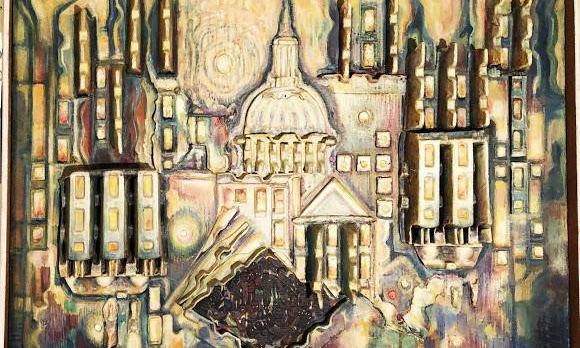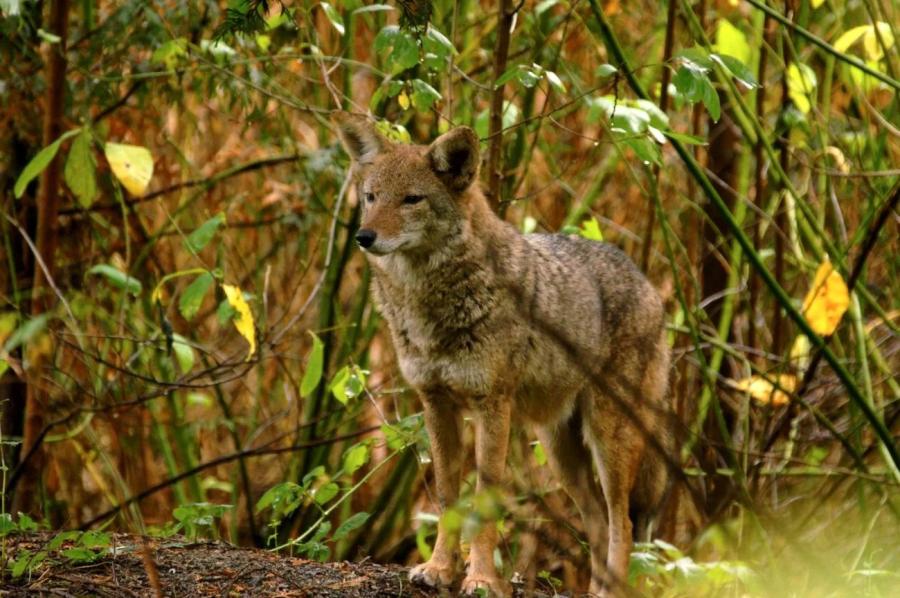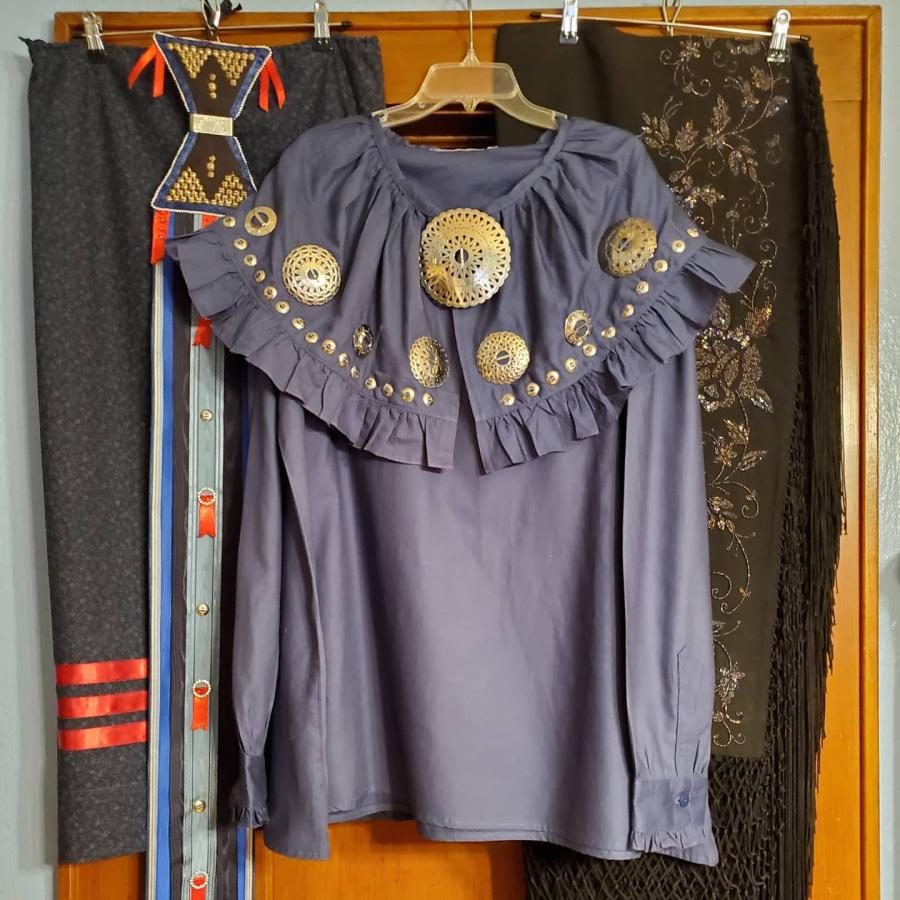
By Michael Auld (Taino)
Michael Auld (Taino) was born in Jamaica and has resided in the Washington D.C. area since college working to raise awareness about Indigenous Washingtonians. He holds a BFA (Cum Laude) and MFA degrees in Design and Art History from Howard University. He has worked in advertising agencies, taught from the elementary through postgraduate levels in his professional disciplines. He is a Visual and Applied Artist with a broad range of experiences in advertising and education, as a sculptor, graphic designer, illustrator, printmaker, cartoonist, writer, storyteller, and published author. Auld and his wife, Rose Powhatan (Pamunkey/Tauxenent), are co-founders of the powhatanmuseum.com website and collection, an educational Amerindian website that provides researched information on two major cultures of the first European encounters in the Americas. These include the Powhatan Confederacy of the Virginia Territory and the Indigenous Peoples of the Caribbean, the Taíno and Kalinago (Island Carib). Follow Auld’s writings at yamaye-mike.blogspot.com, yamaye1.blogspot.com, and anansistories.com.
The 1970 painting below was done by a Pamunkey artist from Washington D.C. who descended from a family of 21 siblings. She was one of many family members with deep roots in the Washington, D.C. Metropolitan area. In keeping with Native American tradition, one must be familiar with their identifying Tribal surnames. In the D.C./Maryland/Virginia (DMV) area, Indigenous names are mainly those associated with Powhatan Paramountcy affiliation. Indigenous Washingtonians live among the city's populations but have just not yet been "discovered" by the mainstream. They are literally “hidden in plain sight.
One of the most overlooked stories of our nation's capital is about Indigenous Peoples in the now Washington, D.C. area. The assumption is that the city is a barren plum only sought after by outside Tribes or other newcomers. D.C. is often thought of as having no real history of its own before the arrival of Europeans. On the contrary, there is a vast underground of local Native Americans who never left the DMV area. Their roots go back over 10,000 years.
Most Indigenous documentaries are not linked to the Powhatan Paramountcy, except for five of whom are Pamunkey and/or Tauxenent. They are Georgia Mills Jessup’s, "We're Still Here", her daughter Rose Powhatan’s "Surviving Document Genocide", and Rose’s sons, Alexei Auld’s "Tonto Canto Pocahontas: A Review," Kiros Auld’s "Pocahontas: Patron Saint of Colonial Miscegenation?", and their cousin's, "Pocahontas' First Marriage: The Powhatan Side of the Story" by Dr. Phoebe Mills Farris. They all have roots in D.C. and have written about their city's Tribal Nations while the Indigenous D.C. history is mostly written by non-Natives.
Unfortunately, D.C.'s Indigenous story is often interpreted by newly arrived Euro-American historians who mostly do not have a clue about who our living Indigenous communities are as well as the international impact of the city's Indigenous Peoples. Some seem unable to connect the dots. One case in point is the portrayal of Pocahontas as a 17th century Virginia Indian first married to widower John Rolfe. His newly introduced Christian religion forced her into a bigamous marriage (see the "Various romanticized versions" of Pocahontas below). To the contrary, Pocahontas was already married to Kocoum, a young war captain with whom she is believed to have had a son. Indigenous men usually moved to their wifes’ villages, so it was from his village, where she had moved for safety, she was lured into abduction with the help of a Patawomeck sub-chief and his wife in Stafford County, VA. Also, it was within her father’s, Powhatan's domain that the boundary stones of the federal city were included.

"Urban Renewal" (1970) by Washingtonian artist Georgia Mills Jessup (Pamunkey).
The darkened center of the "Urban Renewal" painting shows the painter, an Indigenous Washingtonian, surrounded by the city's residential majority at that time. This collage painting is a statement about her city's unseen people of color in their home "under the Capitol," where Indigenous Peoples have become invisible. The city's Indigenous descendants also became “extinct” due to racial politics. Some contemporary Eurocentric skeptics underestimated Indigenous genius, and had little faith in the cultural impact of Powhatan’s immense Indigenous territory with its unique form of Amerindian freedoms within a political group. Although political unions like his had been present in the Americas for thousands of years, one glaring mistake is that some writers believed that Native Americans never ventured out of their immediate Tribal areas. On the contrary, Amerindians traveled extensively and left their homes on long-distance trading expeditions. Models of Amerindian empires abound and their populace included cosmopolitan adventurers. For example, the seafaring Taínos of the Caribbean traveled around the time of the birth of the Jewish Christ, from the Orinoco River Basin in South America, going island by island up into Florida, creating a large civilization with stratified leaderships. Elsewhere in Central and South America, the Spanish had encountered extensive Amerindian political ventures. Archeologists discovered that this type of political process was common in the Americas' vast, highly sophisticated empires.
Powhatan, or Wahunsenacawh's territory, was the largest Indigenous political organization met by the English in 1607, which was governed by one person. However, the main similarity to the pyramid builders was that Powhatan was buried in a pyramid-inspired mound on the Pamunkey Reservation. Their original men were stated as "coming from the south." Some believe they came from the direction of the Yucatec "Pauhatun." An old set of Bacabs, or four-part deity or deities of the four directions and four colors who are also four pillars that hold up the world. This possible Powhatan origin story could be that in addition to similar political acumen in Mesoamerican politics, Powhatan's burial site may have been a part of Central American pyramid-inspired mound building tradition which had spread north to Ohio's 70 mounds. The travel of Mexico's botanical invention of maize had already reached north to Canada centuries before.
Powhatan's power left an indelible impact on the expanding British Empire. The DMV has an unmatched record with published information on one of its Indigenous historic Amerindian groups, the Powhatan Paramountcy (see below). However, the city of Washington, D.C. was built on ancient Indigenous Amerindian ground. It is seen by newcomers to D.C. with no general knowledge of its ancient Indigenous past, as a transient area. Yet, some of its Indigenous citizens have deep, unbroken Native American roots in the Metropolitan area. They are proudly "still here."
Over 100,000 people claim descent from one woman, Pocahontas. Her father, Powhatan had 100 wives, mostly from villages within his domain. Two examples of his lineage are Taux Powhatan whose mother was Tauxenent or Dogue. He was a half-brother to Pocahontas. Keziah Powhatan, an 18th century Tauxenent leader in Fairfax County has many blood relatives in the DMV area. Additionally, many contemporary Indigenous Nations from the Carolinas to Washington, D.C., once within the Powhatan Paramountcy, have descendants from the unions between Powhatan and his wives from those Nations. This common international practice among leaders was to create loyalty to the Paramountcy.
D.C,'s federal city was carved out of at least three Indigenous Algonquian territories of the Nocotchtank, the Pamunkey, and the Tauxenent (or Dogue) and inaugurated on July 16, 1790. Although at the time of Captain John Smith's arrival in 1608, the now extinct Nochotank, had been recorded to have at one time been a part of the Powhatan Paramountcy. The Pamunkey was the leading nation in the Paramountcy to whose governing family Powhatan (or Wahunsenacawh) and Pocahontas belonged. According to historians, these three D.C. Algonquian Tribes were part of the Indigenous group that lived here for 3,000 to 10,000 years prior to the Little Ice Age, which suddenly began in 1275 AD and petered out by 1700 AD.
One example of Indigenous Peoples’ movement during that cooling of the Earth was Maryland’s Piscataway who in 1300 AD came from the freezing North into the Chesapeake shoreline to live among the original Algonquians who were already there thousands of years before. This move ended in 1711 when the Algonquian Piscataway were forced out by the unbridled emigration of their English Catholic "friends." They dispersed and some moved back north to Haudenosaunee (Iroquois) territory, while others went west into the powerful warrior territory of the Powhatan Paramountcy.
As for Anacostia’s Nocotchtank, after their town was bombarded and destroyed by Jamestown residents intent on grabbing the beaver pelt trade, with the help of their Patawomeck allies (who were responsible for the luring and kidnapping of Pocahontas), some surviving Nocotchtank remnants moved to the Tauxenent's Roosevelt Island for a time, then left the area in 1685 to go north to Ohio.
The 1600s were especially violent times in the Americas. To the south, the Spanish extended the American branch of their empire into areas not yet conquered. In the North, Englishmen and women began to move into the Chesapeake area following the enslaving Spanish who had first moved into the Caribbean in 1493, beginning with the arrival of Christopher Columbus’ 17 to19 invading ships. These Iberians euphemistically called themselves “settlers” of territories already settled thousands of years before them. They found it more self-aggrandizing to call themselves “conquistadors,” who were actually pandemic bearers, church and royal sanctioned Amerindian enslavers, murderers, and rapists, as seen in the diary written by Columbus’ Italian friend and lieutenant, Michele da Cuneo. He chronicled the first rape of a Caribbean woman: a rope whipping followed by the rape of a young Carib (Kalinago) woman off the coast of St. Croix in 1493.
The DMV
During the 17th century over 32 local Tribes, mainly from Maryland’s Indigenous Peoples, were forced out of their area by the land-grabbing aggressive English settlers and working class people (mostly called serfs). This antagonistic class set of English men and women sought first time land ownership and riches away from their densely populated European homelands, not similarly endowed with precious reserves. They conveniently believed that their God had given their race domain over the land, animals and the Americas’ Indigenous human beings. The term was “Manifest Destiny.”
The newly formed Virginia Territory's dominant Powhatan Paramountcy who fought three major homeland security Anglo-Powhatan Wars, remained in their area which had been settled by their ancestors 3,000 to 10,000 years before. Known as formidable warriors of a growing empire of Attan Akamik, or “Our Fertile Country,” its capital was called “Tsenacommacah,” or "densely inhabited land." From this location, the Powhatan "Indians" who had developed a complex culture, had a centralized political system of 32-34 Algonquian nations governed by a second Powhatan or “Dreamer” named Wahunsenachaw, who had succeeded his father's eight nations Confederacy.
Also, in the 17th century, many remaining Indigenous Peoples intermarried with arriving foreigners, some, especially those of the Powhatan Paramountcy, never abandoned their ancestral territories. This retention of Indigenous cultures was attributed to descent from matrilineal groups, and was especially true of those whose mothers were Native. The same cannot be said about that portion of Maryland that was not included within the boundary stones of the federal city.
“One of the largest Tribes in the Powhatan [Paramountcy], the Pamunkey Tribe was centered in northern Virginia, with villages in Charles, Prince George's and St. Mary's counties, Maryland.” Virginia’s Tauxenent families also remained in Washington, D.C. proper. Many of these survivors lived in D.C. or daily crossed the Potomac River for educational opportunities as well as for Federal and local government jobs.
By 1711, most Maryland Tribes South and North of Washington, D.C.'s border either became extinct as identifiable Tribal entities within that state’s boundaries or migrated North or West of Washington, D.C. This pattern was not true of those who were a part of the 19,250 square mile Powhatan Paramountcy’s territory whose Accohannock firmly remained in Southern Maryland. Some Powhatan families such as the Tauxenent/Dogue and Pamunkey either remained in Virginia within the federal city’s original boundary, lived in the city, or moved back and forth across the Potomac River for schooling and job opportunities into the redefined 1847 District of Columbia border. The Haudenosaunee (Iroquoian)-speaking Susquehannock on the northern border of the city retreated North to Pennsylvania and New York.
In Virginia, two Indigenous Nations, the Pamunkey and Mattaponi, remained a part of eleven state recognized Tribes. Only seven were federally recognized. Maryland’s state Tribal recognition only began in 2012 with three tribes, one of which (the Accohannock) was a part of the original Powhatan Paramountcy.
Descendants of the Powhatan Paramountcy have continued life in the DMV area as, among other things, 19th century stone quarry miners and masons who were responsible for the construction of iconic D.C. structures such as the Washington Monument, portions of the Capitol Rotunda, the Smithsonian Castle, the "Exorcist Stairs" in Georgetown, canals, bridges and other outstanding D.C. structures. Their accomplishments also included a variety of professions. Many excelled in the arts.
Powhatan Paramountcy descendants fought in or contributed to war efforts from the American Revolution to today’s conflicts. Stories, many books, statues, paintings and movies have chronicled their history, nationally and internationally. The Powhatan Paramountcy is the only Indigenous entity which has continued to have one of the greatest impacts on North American Nations. The following photographs tell it all.

John White's 1585 watercolor of a Secotan woman and child from the Chesapeake Bay, depict people who both probably died almost immediately after contact from an English disease when this watercolor was made.
Powhatan and Pocahontas’ Descendants
Powhatan with some of his wives, by Captain John Smith (1607). Powhatan had 100 wives and his descendants abound from the areas of his Paramountcy. There are over 100,000 people who claim decadency from one woman, Pocahontas. In Europe “30% of all people” are descendants of Charlemagne and his ten children. In Asia, Genghis Khan has a multitude of descendants, while Mohammad is the Middle East’s most famous ancestor.
Images of Pocahontas
One of two statues of Pocahontas with D.C. Native, Rose (Pamunkey/Tauxenent), in Gravesend, Kent, England (1995). A replica of the statue is at Jamestown, Virginia. The town of Gravesend's main claim to fame is that Pocahontas is buried there. Rose Powhatan was a technical assistant to the local St. George's Church high school teacher, Di Colman in that year's annual production of the traveling play, "The Pocahontas Story." The minister, Reverend Wiley, told her that they believe that Pocahonas' grave was located under the church’s altar. The second St. George's Church was built there after the great fire of Gravesend.
"Pocahontas Unmasked" is a print by Rose Powhatan showing her interpretation of the unmasked English version of the princess. She used the image of a 100 percent Native American woman, based on the John White watercolors of 1585.
The "Baptism of Pocahontas" is a large painting of her located in the Capitol Rotunda with Roman-like setting and participants. The original event took place in a more rustic Jamestown. Here the Powhatan attendees sit on the ground as secondary individuals or "savages," as they were sometimes called.
A statue of Cockacoeske, the Queen of Pamunkey who points to the 1677 Treaty, as a Virginia Women's Monument in Capitol Square, Richmond.
Artist Georgia Mills Jessup (Pamunkey) with her grandson, Kiros Auld (Pamunkey/Tauxenent) standing next to their family's Powhatan totem depicting the Mantle of Powhatan, at an annual Chickahominy festival/powwow.
Powhatan's Mantle on display from Oxford's Ashmolean Museum of Art and Archeology, with a school group in London, England.



